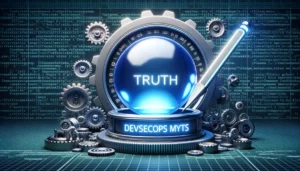The Synergy of DevSecOps and AI/ML

In the ever-changing landscape of software development and IT operations, DevSecOps has emerged as a revolutionary methodology that seamlessly integrates security into the software development process.
But what happens when we supercharge this approach with the capabilities of Artificial Intelligence (AI) and Machine Learning (ML)?
The result is a DevSecOps paradigm that not only strengthens security but also completely transforms the entire software delivery lifecycle. Let’s see how the fusion of DevSecOps and AI/ML and examines how this merger is reshaping the future of software development.
The Fusion of DevSecOps and AI/ML
DevSecOps, as a methodology, has made significant strides by bridging the gaps between development, security, and operations teams. It encourages collaboration, automation, and the smooth integration of security practices throughout the software development lifecycle. On the other hand, AI and ML are renowned for their ability to analyze vast datasets, recognize patterns, and make data-driven decisions. When these two approaches converge, the result is a software delivery paradigm that not only reinforces security but also enhances efficiency and intelligence.
Key Elements of AI/ML-Enhanced DevSecOps
Continuous Surveillance and Anomaly Identification. AI and ML facilitate uninterrupted monitoring of applications and infrastructure. They excel in identifying anomalies and suspicious activities in real-time, instantly triggering alerts or executing preventive measures when irregularities surface.
Threat Intelligence and Predictive Analytics. Leveraging historical data and global threat intelligence, AI/ML can foresee potential security threats and vulnerabilities. This proactive approach empowers organizations to address risks before they escalate into tangible issues.
Vulnerability Assessment and Remediation. AI/ML can diligently scan and assess code for vulnerabilities, prioritize issues, and even provide recommendations for fixes. This accelerates the remediation process, rendering it more streamlined and efficient.
Automation of Security Protocols. Security checks can be automated across the entire software development pipeline, commencing from code reviews and concluding with deployment. This guarantees that security is interwoven into every step, rather than being confined to a post-development phase.
User and Entity Behavior Analytics. AI/ML are adept at recognizing unusual behavioral patterns within an organization’s digital landscape, serving as a robust defense against insider threats and unauthorized access.
Amplified Security Operations Centers. AI/ML elevate the prowess of security operations centers by meticulously processing voluminous data, pinpointing potential threats, and enabling security analysts to concentrate their efforts on critical matters.
Challenges and Considerations
Data Training. AI/ML models necessitate comprehensive training data for effective operation. Organizations must procure and maintain pertinent datasets.
Integration Complexity. The integration of AI/ML into existing DevSecOps pipelines can be intricate and may involve toolchain and process updates.
Ethical Considerations. The development and deployment of AI/ML systems must be conducted responsibly to avert potential biases and ethical dilemmas.
Resource Demands. AI/ML systems can be resource-intensive, demanding both specialized hardware and the expertise to operate them.
AI/ML-enhanced DevSecOps is not just a paradigm shift; it is a transformative leap in software development and security. This amalgamation brings automation, intelligence, and proactive security practices to the very heart of the software delivery process. While certain challenges must be addressed, the benefits of this approach are substantial. Organizations that adopt AI/ML-enhanced DevSecOps are better equipped to thwart threats, secure their software ecosystems, and remain at the forefront in an ever-evolving tech landscape. As AI and ML technologies continue to advance, their integration into DevSecOps is poised to become the cornerstone of future software development practices.










